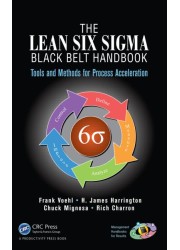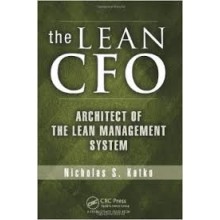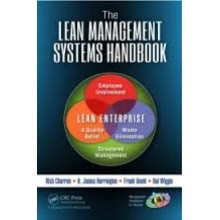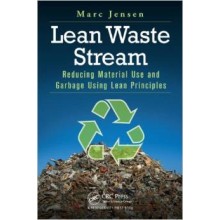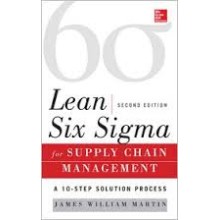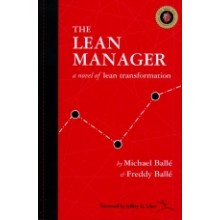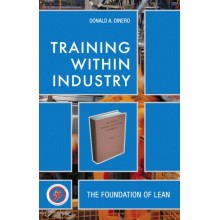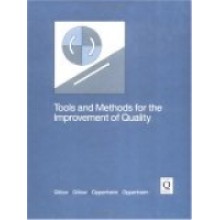The Lean Six Sigma Black Belt Handbook: Tools and Methods for Process Acceleration
ISBN: 9781466554689
Author: Frank Voehl, H. James Harrington, Chuck Mignosa, Rich Charron
Dispatch Time: 15 - 30 Days
Quantity:
-
Add to Compare
Although Lean and Six Sigma appear to be quite different, when used together they have shown to deliver unprecedented improvements to quality and profitability. The Lean Six Sigma Black Belt Handbook: Tools and Methods for Process Acceleration explains how to integrate these seemingly dissimilar approaches to increase production speed while decreasing variations and costs in your organization.
Presenting problem-solving tools you can use to immediately determine the sources of the problems in your organization, the book is based on a recent survey that analyzed Six Sigma tools to determine which are the most beneficial. Although it focuses on the most commonly used tools, it also includes coverage of those used a minimum of two times on every five Six Sigma projects.
Filled with diagrams of the tools you’ll need, the book supplies a comprehensive framework to help you for organize and process the vast amount of information currently available about Lean, quality management, and continuous improvement process applications. It begins with an overview of Six Sigma, followed by little-known tips for using Lean Six Sigma (LSS) effectively. It examines the LSS quality system, its supporting organization, and the different roles involved.
Identifying the theories required to support a contemporary Lean system, the book describes the new skills and technologies that you need to master to be certified at the Lean Six Sigma Black Belt (LSSBB) level. It also covers the advanced non-statistical and statistical tools that are new to the LSSBB body of knowledge.
Presenting time-tested insights of a distinguished group of authors, the book provides the understanding required to select the solutions that best fit your organization's aim and culture. It also includes exercises, worksheets, and templates you can easily customize to create your own handbook for continuous process improvement.
Designed to make the methodologies you choose easy to follow, the book will help Black Belts and Senseis better engage their employees, as well as provide an integrated and visual process management structure for reporting and sustaining continuous improvement breakthroughs and initiatives.
Table of Contents
OVERVIEW OF LEAN SIX SIGMA
Introduction to Lean Six Sigma Methodology
In a Nutshell
Introduction
The Notion of Standing upon the Shoulders of Giants
LSS Cultural Building Blocks
Connecting the Tools with Engineering Goals
What Came First—Six Sigma or Lean?
Technical Competency Levels
LSS Belt Levels
Lean Six Sigma Master Black Belt (LSSMBB)
Lean Six Sigma Black Belt (LSSBB)
Lean Six Sigma Green Belt (LSSGB)
Lean Six Sigma Yellow Belt (LSSYB)
Lean Six Sigma Blue Belt
Five Phases of an LSS Improvement Project
Summary
Process Improvement and Lean Six Sigma
In a Nutshell
Introduction
AN LSS Quality Focus on the Business Process
Some Basic Definitions
Objectives of Process Improvement
Cross-Functional Focus
Critical Success Factors
Nature of LSS Process Improvement
Advantages of LSS Process Improvement
Determining Process Ownership
The Nature of Business Processes
Management’s Traditional Focus
Cross-Functional Focus
Process Ownership
The Process Owner
The Process Management Committee
The Process Quality Team
Selection, Responsibilities, and Authority of the Process Owner
Selection of the Process Owner
Responsibilities of the Process Owner
Authority of the Process Owner
Process Definition and the Process Model
Definition of Process Mission and Scope
Summary
Exercise
THE LEAN JOURNEY INTO PROCESS IMPROVEMENT
Waste Identification
In a Nutshell
Overview
What Is Variation?
How Do We Chart Variation?
Why Is Understanding and Controlling Variation So Important?
What Is Waste?
Defining the Value-Added Work Components
How Does Waste Creep into a Process?
The Power of Observation
Seeing with New Eyes
Waste 1: Overproduction
What Causes Overproduction?
How to Identify Overproduction
Waste 2: Excess Inventories
What Causes Excess Inventory?
How to Identify Excess Inventory
Waste 3: Defects
What Causes Defects?
How to Identify Defects
Waste 4: Extra Processing
What Causes Processing Waste?
How to Identify Processing Waste
Waste 5: Waiting
What Causes Waiting Waste?
How to Identify Waiting Waste
Waste 6: Motion
What Causes Motion Waste?
How to Identify Motion Waste
Waste 7: Transportation
What Causes Transportation Waste?
How to Identify Transportation Waste
Waste 8: Underutilized Employees
What Causes Underutilized Employees Waste?
How to Identify Underutilized Employee Waste
Waste 9: Behavior
How to Identify Behavior Waste
Summary
Lean Concepts, Tools, and Methods
Overview
Traditional Organization Operational Philosophy
Lean Operational Philosophy
Lean Management Concepts
Waste
Value-Added Activities
No-Value-Added Activities
Business-Value-Added Activities
Waste Identification
Waste Elimination
Value Stream
Value Stream Management
Continuous Flow
Pull Systems
Point of Use Storage
Quality at the Source
Just-in-Time
Kaizen
5M’s—Materials, Machines, Manpower, Method, and Measurements
Key Process Input Variables (KPIVs)
Key Process Output Variables (KPOVs)
Lean Tools
5S Workplace Organization and Standardization
Just the Facts
5S Means Action
Common Omissions When Implementing 5S
Overall Equipment Effectiveness
Just the Facts
How to Use OEE
Applying OEE in Nonmanufacturing Environments
Mistake Proofing
Just the Facts
How to Use Mistake Proofing
Cellular Manufacturing
Just the Facts
How to Create Manufacturing Cells
Kanban
Just the Facts
How to Use Kanban
Value Stream Mapping
Just the Facts
Managing with Maps
Visual Controls
Just the Facts
How to Use Visual Controls
The Power of Lean Concepts and Lean Tools
Composite U-Cell Case Study
Lean Six Sigma Concepts and Tools Used
Summary
Three Faces of Change—Kaizen, Kaikaku, and Kakushin
In a Nutshell
Introduction
Resistance to Change
Fear of the Unknown
Measurement Systems
Beliefs
Overcoming Resistance to Change
Leaving Old Beliefs Behind
Considering New Possibilities
Emergence of LSS
Three Faces of Change
Kaizen—Continuous Improvement
Kaizen and You Method
Kaizen for Process Troubleshooting
Step 1: Go to Gemba
Step 2: Conduct Gembutsu
Step 3: Take Temporary Countermeasures "on the Spot"
Step 4: Find Root Causes
Step 5: Standardize to Prevent Recurrence
Kaizen Teams
Possible Target Areas for Kaizen Teams
Preparing for Kaizen
Team Member Roles in Kaizen
Overcoming Obstacles during Kaizen
Kaikaku—Transformation of Mind
How Do We Recognize Kaikaku (Transformation of Mind)?
Kaikaku in Cell Design
Kaikaku in Facility Layouts
Kakushin (Innovation)
The 20-20 Innovation Process
Summary
SSBB OVERVIEW
On Integrating LSS and DMAIC with DMADV
In a Nutshell
Overview
Goals of Lean DMADV
Lean Design
Goals of DMAIC/DMADV
Overview of How DMAIC Works
Overview of How DMADV Works
Comparing DMAIC and DMADV
Integrating Lean with DMAIC/DMADV
Root Cause Analysis and Lean
Groups of Root Cause Analysis Tools
Summary
LSSBB ADVANCED NONSTATISTICAL TOOLS
Black Belt Nonstatistical Tools (A through M)
Introduction
5S
Just the Facts
Example
Additional Reading
Benchmarking of Processes
Just the Facts
What Will Benchmarking Do for You?
History of Benchmarking
Types of Benchmarking
Internal Benchmarking
External Benchmarking
Guidelines and Tips
What Are the Primary Reasons for Using Process Benchmarking?
The What
The How
The Five Phases of Internal and External Combined Benchmarking Process
Examples
Additional Reading
Bureaucracy Elimination Methods
Just the Facts
Process-Focused Approach
Incident-Focused Approach
Examples
Example 1
Example 2
Example 3
Additional Reading
Conflict Resolution
Just the Facts
Example
Additional Reading
Critical to Quality
Just the Facts
Critical to Quality (CTQ) Characteristics
Example
Additional Reading
Cycle Time Analysis and Reduction
Just the Facts
Applications of Cycle Time Analysis and Reduction
Cycle Time Analysis and Reduction Process
Examples
Additional Reading
Fast-Action Solution Technique (FAST)
Just the Facts
Examples
Additional Reading
Foundation of Six Sigma (Minimizing Variation)
Just the Facts
What Does "Good Enough" Mean?
Example
Additional Reading
Just-in-Time (JIT)
Just the Facts
Example
Additional Reading
Matrix Diagram/Decision Matrix
Just the Facts
L-Shaped Matrix
T-Shaped Matrix
Guidelines and Tips
Examples
Additional Reading
Measurements
Just the Facts
Principles of Good Measure
Examples
Quality Measurement
Additional Reading
Black Belt Nonstatistical Tools (O Through Q)
Organizational Change Management (OCM)
Just the Facts
Seven Phases of OCM
Phase I: Defining Current State Pain
Phase II: Establishing a Clear Vision of the Future State Solution
Phase III: Defining Change Roles
Phase IV: Mapping Change Roles
Phase V: Defining the Degree of Change Required
Phase VI: Developing the Organizational Change Management Plan
Phase VII: Implementing the Change Management Plan
Examples
Additional Reading
Pareto Diagrams
Just the Facts
The Pareto Principle (80/20 Rule)
Uses of Pareto Diagrams
Classifications of Data
Constructing a Pareto Diagram
Example
Prioritization Matrix
Just the Facts
Example
Additional Reading
Project Management (PM)
Just the Facts
Project Management Knowledge Areas
Project Integration Management
Project Scope Management
Project Time Management
Project Cost Management
Project Quality Management
Project Human Resource Management
Project Communications Management
Project Risk Management
Project Procurement Management
How OCM Can Help
Estimate Task Effort and Duration
Develop the Schedule
Project Management Software
Project Management Software Selection
PMBOK Tools and Techniques
Examples
Additional Reading
Quality Function Deployment (QFD)
Just the Facts
Using QFD
Voice of the Customer
Part Deployment Phase
The Process Plan and Quality Plan Matrices
The Roof of the House of Quality
Operating Instructions
Summary
Examples
Additional Reading
Black Belt Nonstatistical Tools (R through Z)
Introduction
Reliability Management System
Just the Facts
Phase I: Defining Reliability Requirements
Phase II: Designing Reliability into the Item
Phase III: Defining Component Reliability
Phase IV: Calculating the Item’s Reliability
Phase V: Minimizing Manufacturing Degradation
Phase VI: Qualifying the Item
Phase VII: Measuring Customer/Consumer Reliability
Phase VIII: Corrective Action and Database Updating
Examples
Additional Reading
Root Cause Analysis
Just the Facts
How to Do a Root Cause Analysis in Six Steps
Examples
Scatter Diagrams
Just the Facts
Steps to Prepare a Scatter Diagram
Guidelines and Tips
Example
Additional Reading
Selection Matrix (Decision Matrix)
Just the Facts
Example
Additional Reading
SIPOC Diagram
Just the Facts
The SIPOC Approach Expanded
Building a SIPOC Diagram
Example: Mama Mia Case Study
Mama Mia’s SIPOC—Food Storage Process
Mama Mia’s SIPOC—Food Preparation and Order Delivery
SWOT—Strengths, Weaknesses, Opportunities, and Threats
Just the Facts
The SWOT Matrix
Example
Additional Reading
Takt Time
Just the Facts
Example
Additional Reading
Theory of Constraints (TOC)
Just the Facts
Types of (Internal) Constraints
Example
Additional Reading
Tree Diagrams
Just the Facts
Examples
Additional Reading
Value Stream Mapping
Just the Facts
Example
Additional Reading
LSSBB ADVANCED STATISTICAL TOOLS
Advanced Statistical Tools
Analysis of Variance (ANOVA)—One-Way
Just the Facts
Example
Analysis of Variance (ANOVA)—Two-Way
Just the Facts
Major Considerations
Example
Box Plots
Just the Facts
Example
Confidence Intervals
Just the Facts
Example
Confidence Interval for the Mean
Confidence Interval for the Standard Deviation
Confidence Interval for the Proportion Defective
Data Transformations
Just the Facts
Data Transformation Types
Standard Transformation Functions
Example
Application Cookbook
Design of Experiments
Just the Facts
Steps in Designing an Experiment
Principles of an Experimental Design
Setting up the Appropriate Experiment
Analysis (of Means and Variance) Methodologies
Analysis of Means
Paired Comparison
Analysis of Variance Methodology
One-Way and Two-Way ANOVA
One-Way ANOVA
Example Experiment 1
Example Experiment 2
Two-Way ANOVA
Types of Experimental Designs
Applications of DoE
DoE Steps
Experimental Objectives
Select and Scale the Process Variables
Design Guidelines
A Typical DoE Checklist
The Iterative Approach to DoE
Experimental Assumptions
Is the Measurement System Capable?
Is the Process Stable?
Are the Residuals Well Behaved?
Interactions
Categories of Experimental Designs
Three-Factor, Three-Level Experiment
Randomized Block Plans
Latin Square Designs
Graeco-Latin Designs
Plackett-Burman Designs
Taguchi Designs
Mixture Designs
Simplex-Lattice Designs
Steepest Ascent/Descent
Response Surfaces
EVOP Evolutionary Operations
When to Use Which Design
Project Strategies
Data Analysis
Experimental Designs
Response Surface Designs
Project Strategy Decision Table
References
Background References
Measurement Systems Analysis (MSA)
Just the Facts
Example
Approaches to Attribute MSA
Method of Least Squares
Just the Facts
Example
Multivari Charts
Just the Facts
Example
Nonparametric Statistical Tests
Just the Facts
Example
Sign Test for the Median
One-Sided Wilcoxon Test
Two-Sample Mann-Whitney
Kruskal-Wallis
Mood’s Median Test
Friedman Test for a Randomized Block Design
Populations and Samples
Just the Facts
Uncertainty in the Mean—Conclusions
Data Defined
Summary of Data Types
Process Measurements Summary
Example
Regression Analysis
Just the Facts
Simple Linear Regression
Multiple Linear Regression
Curvilinear Regression
Other Linear Regression Models
Caution
Example
Rolled-Throughput Yield
Write a review
Your Name:Your Review: Note: HTML is not translated!
Rating: Bad Good
Enter the code in the box below:
Copyright © 2014 Engineering Standards Bureau. All Rights Reserved.
Developed By Zoom Into Web


